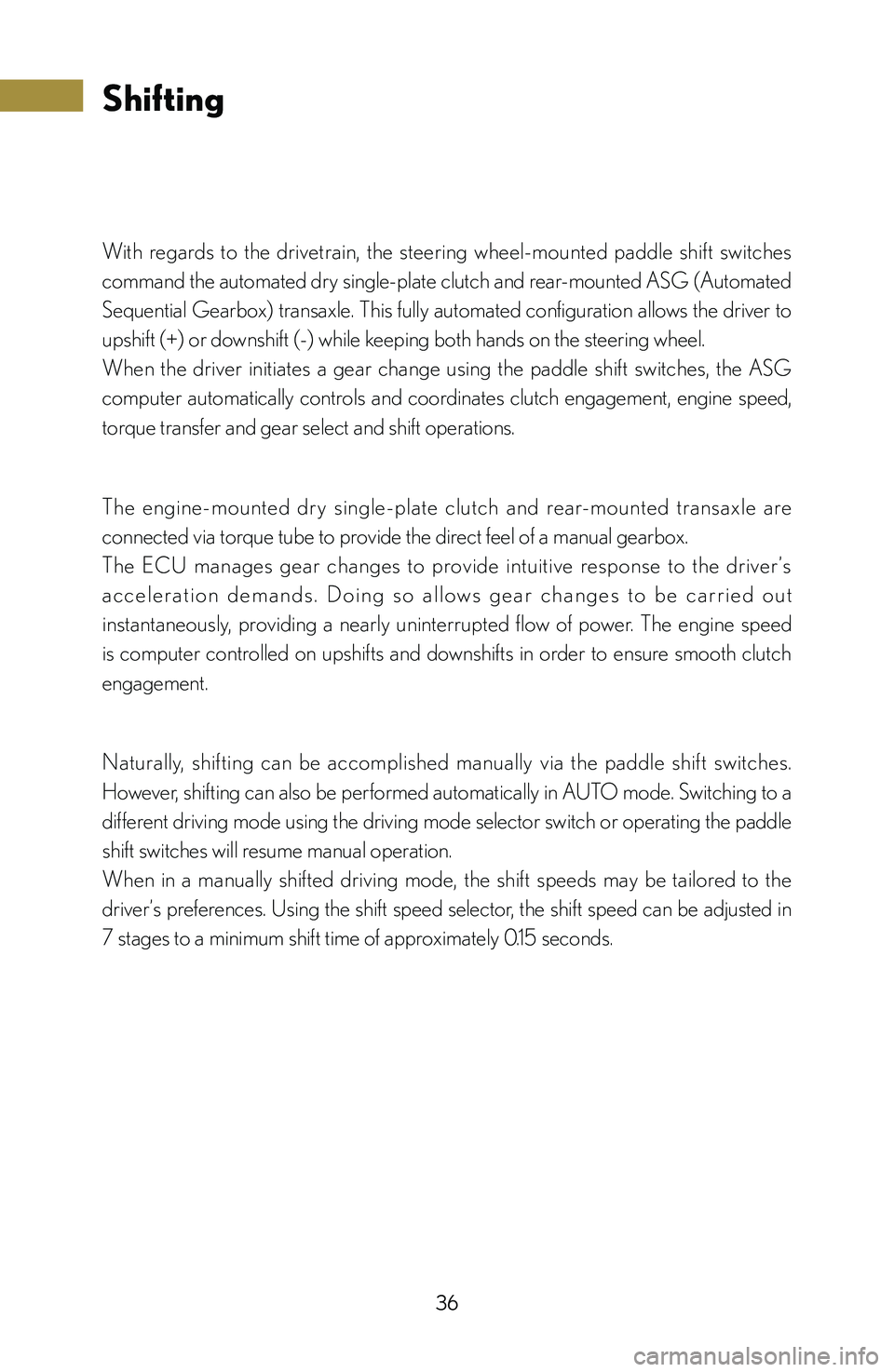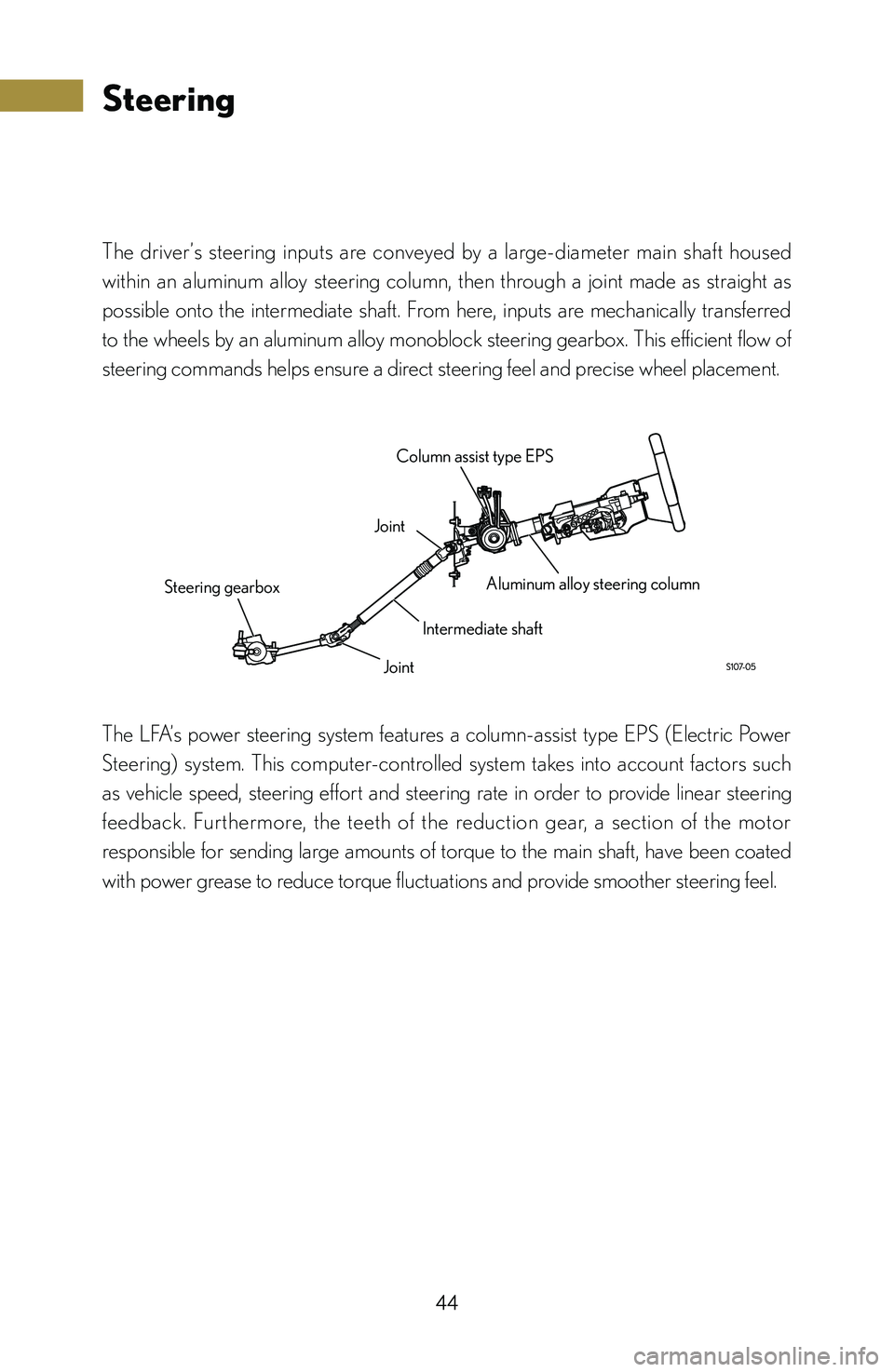2012 Lexus LFA torque
[x] Cancel search: torquePage 18 of 128

16
Engine protection mechanisms
The LFA’s 1LR-GUE engine generates a maximum output of 412 kW (553 HP) at
8,700 rpm and delivers 90% or more of its peak torque of 354 ft•lbf (480 N•m,
48.9 kgf•m) between 3,700 and 9,000 rpm. The engine features a number of
protection mechanisms to ensure longevity and maintain peak performance.
A number of driving restrictions will be in place until the total mileage shown on the
odometer exceeds 310 miles (500 km). This break-in period serves not only to
protect the engine, but also to preserve the transmission, suspension and the vehicle
as a whole. It is recommended that during this time the owner become familiar with
the LFA and avoid high-load driving maneuvers.
One engine protection mechanism in place beyond the break-in period is the limiting
of maximum engine speed when the engine is cold. When the vehicle is cold started,
various components within the engine begin to warm up and expand at different rates.
Forcing the engine to operate at high speeds in this condition can cause accelerated
engine wear. For this reason, the maximum engine speed is limited when manually
shifted driving modes (SPORT, NORMAL, WET) are selected and restricted to a set
range when AUTO mode is selected.
This engine speed limitation does not indicate a malfunction with the vehicle. Warming
the engine up by driving, rather than extended idling, is recommended.
Page 31 of 128

29
Operating the driving mode selector switch
■
■VDIM
The LFA employs VDIM (Vehicle Dynamics Integrated Management), a dynamic
control program that integrates braking and drive torque control to help ensure
overall vehicle stability and secure handling. VDIM also features vertical acceleration
and roll rate sensors, added exclusively for the LFA. The addition of these sensors
increases the precision and response of road camber estimation on banked roads,
such as “The Carousel” at the Nürburgring, to determine the vehicle’s performance
limits. This prevents excessive intervention on banked roads.
The LFA’s VDIM system allows for two individual control modes selected by the driver
using the driving mode selector switch.
When in SPORT mode, VDIM control is modified in order to enhance driving
pleasure and the driver’s confidence in the vehicle.
When not in SPORT mode, VDIM returns to NORMAL mode, designed to intervene
seamlessly as the vehicle reaches its performance limits, thereby realizing smoother
driving dynamics.
This helps ensure both overall vehicle stability and secure handling.
Page 38 of 128

36
Shifting
With regards to the drivetrain, the steering wheel-mounted paddle shift switches
command the automated dry single-plate clutch and rear-mounted ASG (Automated
Sequential Gearbox) transaxle. This fully automated configuration allows the driver to
upshift (+) or downshift (-) while keeping both hands on the steering wheel.
When the driver initiates a gear change using the paddle shift switches, the ASG
computer automatically controls and coordinates clutch engagement, engine speed,
torque transfer and gear select and shift operations.
The engine-mounted dr y single-plate clutch and rear-mounted transaxle are
connected via torque tube to provide the direct feel of a manual gearbox.
The ECU manages gear changes to provide intuitive response to the driver ’s
a c c e l e r a t i o n d e m a n d s . D o i n g s o a l l o w s g e a r c h a n g e s t o b e c a r r i e d o u t
instantaneously, providing a nearly uninterrupted flow of power. The engine speed
is computer controlled on upshifts and downshifts in order to ensure smooth clutch
engagement.
Naturally, shifting can be accomplished manually via the paddle shift switches.
However, shifting can also be performed automatically in AUTO mode. Switching to a
different driving mode using the driving mode selector switch or operating the paddle
shift switches will resume manual operation.
When in a manually shifted driving mode, the shift speeds may be tailored to the
driver’s preferences. Using the shift speed selector, the shift speed can be adjusted in
7 stages to a minimum shift time of approximately 0.15 seconds.
Page 40 of 128

38
■
■Torque tube
Employing a torque tube to unite the front-mounted engine with the rear-mounted
transaxle creates an outstanding level of powertrain rigidity.
This aspect is essential in order to extract the most performance out of a vehicle. A
rigid powertrain reduces parasitic losses that occur from unwanted engine movement
and input from the wheels, allowing a greater amount of power to be sent to the road
and a more direct response.
Torque is transferred by means of an input shaft housed within the torque tube. This
fast-spinning shaft is mounted using rubber insulators with integrated bearings to
ensure quietness.
Torque tube
Rubber dampers with integrated bearings
Input shaft
Front counter gear Input shaft
A front counter gear is employed,
allowing the engine to be placed
closer to the ground. The engine
crankshaf t axis is lower to the
ground than the input shaft axis.
Crankshaft axis
Front counter gear
Page 41 of 128

39
Shifting
■
■Rear transaxle
The LFA’s gear change mechanism consists of a parallel two-shaft layout often used
in modern manual transmissions. In the LFA, the transmission and differential are
integrated and placed near the rear axle, thus realizing a rear transaxle configuration.
Gear shift and select commands are sent by the ECU to a hydraulically operated shift
mechanism for fast and precise operation.
To ensure ample strength and the ability to handle the engine’s broad torque curve,
various areas throughout the transaxle have been reinforced and high-capacity three-
point contact bearings have been adopted. Furthermore, each synchronizer ring
employs a high-friction carbon material to realize quicker engagement and faster
shifts. Additionally, the teeth of all speed gears have been micro-polished for precise
engagement and reduced gear whine.
The transaxle employs its own oil pump and oil cooling system to ensure a constant
supply of oil at a stable temperature even under demanding endurance conditions.
3rd 6th 5th 2nd 1st
Support bearings
Regarding synchronizers, 1st through 4th gears employ triple-cone units while 5th and 6th
gears are double-cone. A TORSEN
® LSD (Limited Slip Differential) with a specific amount
of preload dialed in has been adopted to ensure excellent traction and handling stability.
TORSEN
® LSD is a registered trademark of JTEKT. 4th
Page 43 of 128

41
Shifting
■
■Driving mode-specific shift characteristics
The driving mode selector switch allows the driver to choose the automatically shifted
AUTO mode or a manually shifted SPORT, NORMAL or WET mode and their
corresponding default shift speed level. The driver may perform gear changes using the
paddle shift switches while driving in a manually shifted driving mode. While the shift speed
is adjustable using the shift speed selector, each driving mode has its own default shift
speed setting. Shift speeds are determined by how quickly the following operations are
carried out: Clutch disengagement, gear select, gear shift and clutch engagement.
Selecting a faster shift speed will shorten the time it takes from the moment the paddle shift
switch is pulled until the shift is totally completed. Faster shift speeds allow for enhanced
response and near-seamless power delivery, but will also result in a greater amount of shift
shock due to the speed at which the aforementioned operations are carried out. Selecting
a slower shift speed will allow the clutch and gear shift/select mechanisms to operate at a
more gentle pace, leading to a smoother application of torque and less shift shock.
Driving modeDriving mode default shift speed
AUTO ■■
2/7 (Non-adjustable)
SPORT ■■■■■□□
5/7
NORMAL ■■■□□□□
3/7
WET ■□□□□□□
1/7
Shift characteristicsLevel 1 n Level 7
Shift speed Slow (approx. 1 sec.) n
Fast (approx. 0.15 sec.)
Shift shock Less n
More
Shift speed selector
When in a manually shif ted driving
mode (SPORT, NORMAL or WET),
the shift speed can be adjusted from
l e v e l 1 t o 7 u s i n g t h e s h i f t s p e e d
selector.
Shift speed is also determined by the
accelerator pedal angle. The more the
accelerator pedal is depressed, the
shorter the shift times will be.
S106-04
Fast
Slow
Fully released Fully
depress
Level 1
Level 2 Level 7
Accelerator
pedal angle
Shift speed
Page 46 of 128

44
Steering
The driver’s steering inputs are conveyed by a large-diameter main shaft housed
within an aluminum alloy steering column, then through a joint made as straight as
possible onto the intermediate shaft. From here, inputs are mechanically transferred
to the wheels by an aluminum alloy monoblock steering gearbox. This efficient flow of
steering commands helps ensure a direct steering feel and precise wheel placement.
Joint Column assist type EPS
Aluminum alloy steering column
Intermediate shaft
Joint
Steering gearbox
The LFA’s power steering system features a column-assist type EPS (Electric Power
Steering) system. This computer-controlled system takes into account factors such
as vehicle speed, steering effort and steering rate in order to provide linear steering
feedback. Furthermore, the teeth of the reduction gear, a section of the motor
responsible for sending large amounts of torque to the main shaft, have been coated
with power grease to reduce torque fluctuations and provide smoother steering feel.
Page 112 of 128

110
Engine
Engine Type1LR-GUE
No. of Cyls. & Arrangement 10-cylinders, 72°V type
Valve Mechanism 40-valve DOHC, Rocker Arm Type
Bore x Stroke 88.0 mm x 79.0 mm
Displacement 4,805 cm
3
Compression Ratio12.0:1
Spark Plug Type
*1PK22HTBR-L8 (DENSO)
Engine Oil “Mobil 1 5W-50” API SM or SN
Engine Oil Capacity
*2Single Oil Cooler 13.5 L (14.2 qt., 11.9 Imp. qt.)
Twin Oil Cooler 14.5 L (15.3 qt., 12.8 Imp. qt.)
Lubrication Type Dry Sump
Coolant Type Super Long Life Coolant
Coolant Capacity 25.5 L (26.9 qt., 22.4 Imp. qt.)
Max. Output (SAE-NET) 412 kW (560 PS) 8,700 rpm
Max. Torque (SAE-NET) 480 Nm (48.9 kgf•m) 7,000 rpm
Maximum Engine Speed 9,000 rpm
*1: The spark plugs have been developed exclusively for the 1LR-GUE engine.*2: The figure shown is the total amount of oil contained in the engine, and not the amount of oil required for an oil change.
Engine powerband (Internal measurement)
Engine speed (rpm)
Power (kW)
Torque (Nm)
2,000
450
400
350
300
250
200
150
100
50
0 4,000 6,000 8,000 10,000 500
400
300